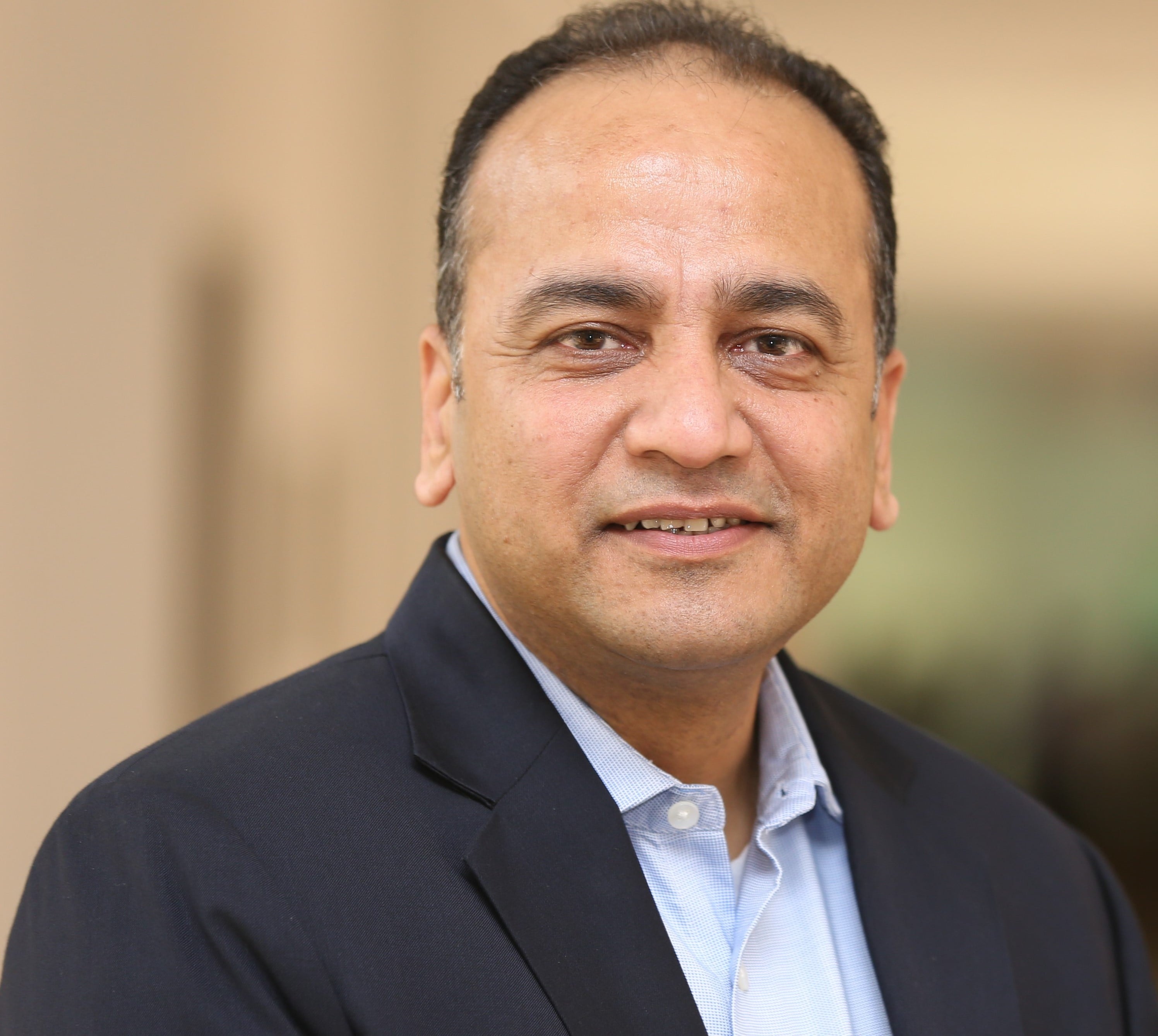
Toward student-centricity Revamping Indian higher education for the future of work
20 minute read
11 June 2020
Today’s learner is evolving and seeks a change from traditional teaching methods. It’s time for Indian educators to become student-centric and revisit their leadership, mindset, and pedagogical approaches for better education delivery.
Executive summary
The future of work and the emergence of new roles defined by renewed skills sets are changing the landscape for talent demand across the globe. Learners need to equip themselves with in-demand skills for better employability prospects in the market. They realize that “once and done” is not enough and are slowly embracing the concept of continuous learning to be employable and market-ready at all times. Additionally, they are increasingly opting for interactive and self-paced methods of learning.
Learn more
Explore future of higher education in India collection
Learn about Deloitte's services
Go straight to smart. Get the Deloitte Insights app
To ensure student-centric learning, the traditional education model characterized by silo-based learning and exam-based methods of evaluation needs to be replaced by innovative methods of delivering education. There is an urgent need to understand what educational institutions can do to align their strategy with students’ expectations and the ever-changing dynamics of the future of work.
Based on the on-going research, survey analysis, and discussions with educational leaders (see sidebar, “About the research”), three key themes emerged that educators can consider to course-correct:
- Creating a forward-looking leadership: Educators need to consider replacing traditional leadership models with a new set of leadership strategies that are visionary yet implementable. They need to wear multiple hats—that of a catalyst, strategist, steward, and operator.
- Building a growth mindset: Educators also need to provide students with a conducive environment, one which motivates them to build on their abilities. Students should be exposed to a growth mindset that values efforts over intelligence and rewards out-of-the-box thinking.
- Redesigning learning models: Institutional leaders need to experiment with new and innovative platforms for learning, helping students develop critical skills and preparing them for life-long learning.
It is, however, important to note that educators will not be able to achieve this in a vacuum and will have to rely on the collective intelligence of six important stakeholders, including government, industry, faculty, students, parents, and alumni.
About the research
In December 2019, Deloitte surveyed three important groups of stakeholders (i.e., academicians, students, and alumni) in the higher education sector to understand their perspectives on whether institutions are making targeted efforts to build the workforce of tomorrow. In all, 64 academicians, 2,552 students, and 515 alumni responded to the survey. In January 2020, Deloitte organized the Empowered Educators Summit across four cities including Delhi/NCR, Mumbai, Hyderabad, and Bengaluru, where deans and educators took part in panel discussions and lab sessions to discuss the importance of transforming leadership capabilities, cultivating a growth mindset, and developing innovative learning models to ensure today’s and tomorrow’s learners are better prepared. This article summarizes the key themes identified during the summit and the primary findings of the survey to suggest a possible path forward for Indian educational institutions.
Amid disruption, the onus is on educators to rejig the system
Automation is expected to impact around 69 percent of jobs in the country.1 Roles requiring traditional skill sets are slowly being substituted with roles based on a renewed set of skills.2 Research suggests that by 2022, demand for skills such as reading, writing, and quality control will decline while analytical, critical thinking, and emotional intelligence skills will be in demand.3
Is the present and the future workforce being equipped adequately with new-age skills? Probably not. Besides, there exists a visible gap between the way learners prefer to consume education and the way it is being delivered.
The new-age learners are distinct. A significant percentage of today’s learners have a lower attention span, prefer flexible and digital methods of learning, and are older than 25 years.4 Moreover, they are more inclined toward interdisciplinary, interactive, and simulative methods of learning. Over 80 percent of students in our survey suggested a preference for experiential methods of learning. What’s more, the reduced half-life of a skill to just about five years, or less, has necessitated continuous learning and upskilling.5 Therefore, an environment that fosters learning, unlearning, and relearning is expected to become the new normal going ahead.
To keep pace with the shifting dynamics of learning, institutions need to transition toward a flexible model of education, one that permits students to subscribe to an institution on a lifetime basis, that enables them to toggle between classroom training and the work world, and that ensures that learning cuts across disciplines.6 To achieve this transition, we propose that educational institutions predicate their revamp strategy on three essential pillars:
- Creating a forward-looking leadership
- Building a growth mindset
- Redesigning learning models
Institutions need leaders who can look beyond the obvious, who acknowledge external disruptions, and who strive to build a resilient workforce. They need to perform different roles, that of a catalyst, strategist, steward, and operator, to streamline the transition toward a learner-centric institution.
The current mindset that puts intelligence on a pedestal needs rethinking. Institutions need to embrace the growth mindset, one which places efforts above intelligence. Some of the ways in which educators can achieve this are by encouraging students to view failure as an opportunity to learn, fostering a learning culture that rewards risk, and replacing exam-based evaluation with constructive feedback.
Today’s learners prefer digital courses, flexible classes, and interactive learning. Educational leaders, therefore, need to constantly experiment with different methods of learning. Experiential learning, interdisciplinary learning, and life-long learning are some of the learning methods that some institutions have already started to implement.
In the next few sections, we explore these three foundational pillars (figure 1) in detail and the way they can interact with each other to ensure student-centric outcomes.
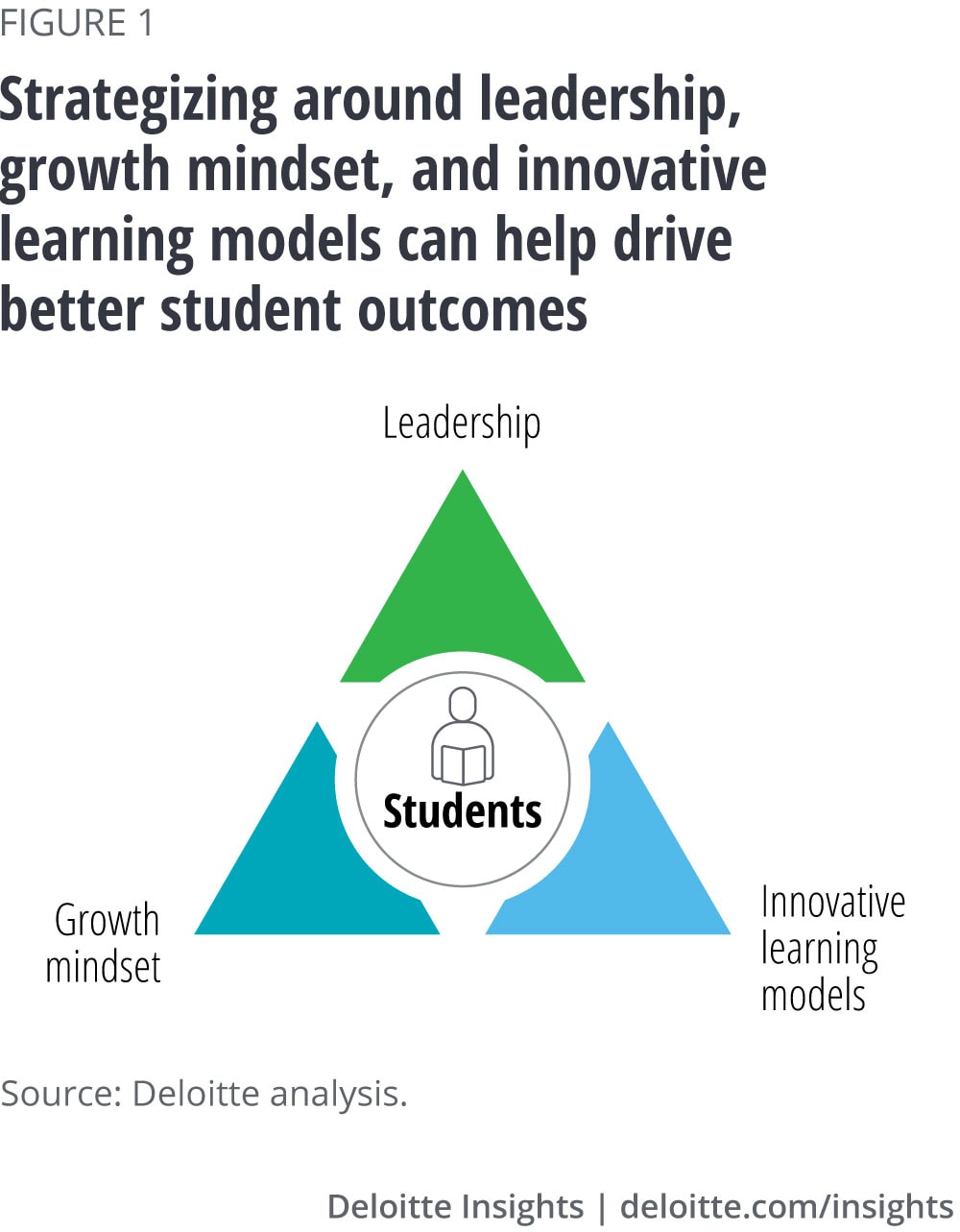
Pillar No. 1. Creating a forward-looking leadership
Nearly 92 percent of academicians in our survey agreed that higher education institutions are majorly responsible for shaping the workforce of the future.7 Leaders at the helm of these institutions, therefore, need to morph their strategy in line with the changing nature of the future of work.
To see the landscape around them through a forward-looking lens, and think, act, and react accordingly, education leaders can draw inspiration from leaders across industries, who are upgrading their skills to meet the demands of the disruptive world while also encouraging organizational staff to adapt to the change. Leaders in these organizations are adopting novel leadership frameworks; educators can do the same. A good way to do it would be to align their strategy along the lines of the “four faces” framework for C-suite leaders.8 They can operate taking on the four roles—that of a catalyst, strategist, steward, and operator (figure 2)—that the framework presents.9
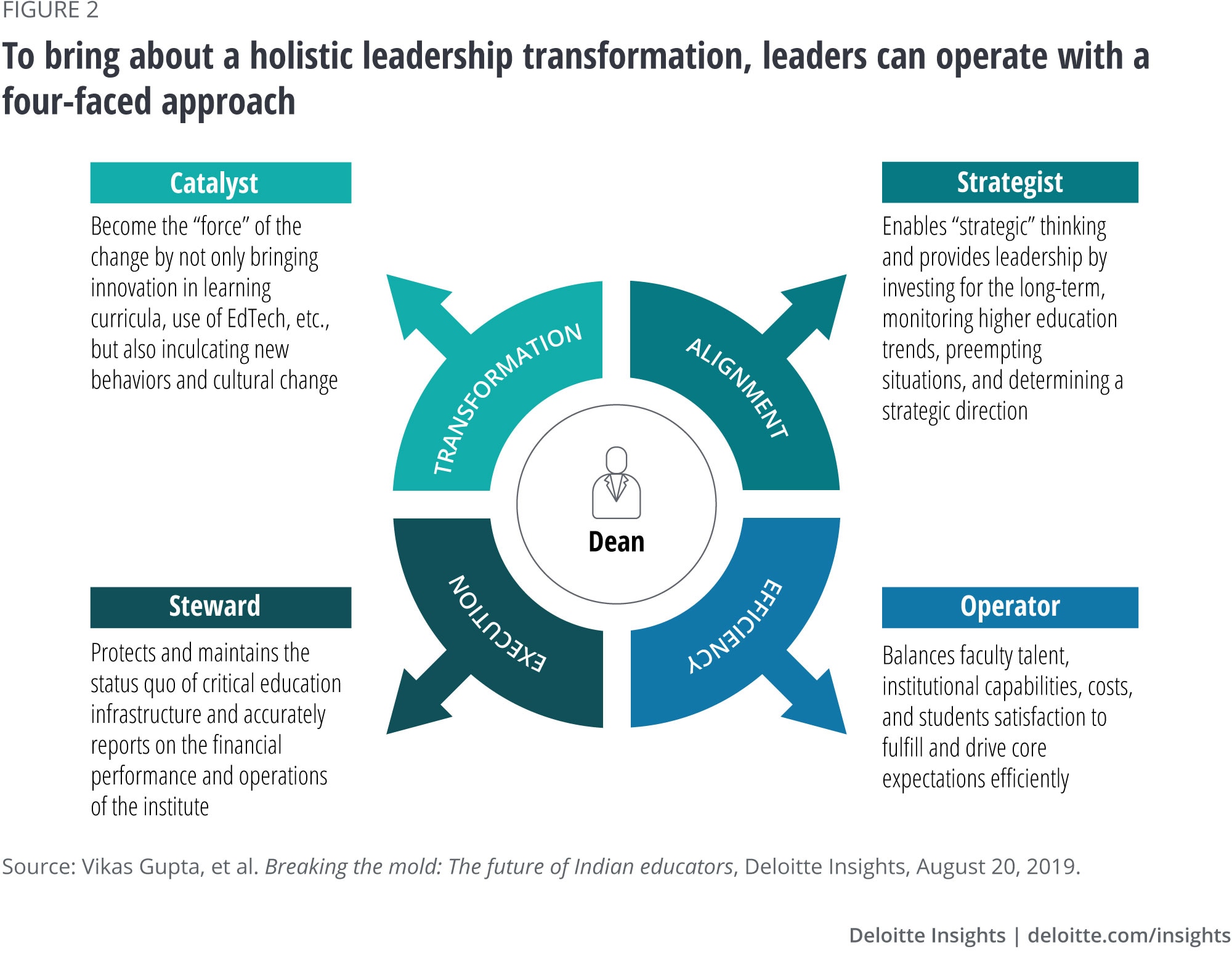
Educators can be better prepared for the future of work if they move between these four organizational roles nimbly:
- As a catalyst, they will have to be the drivers of change and innovate learning, implement and eventually scale the use of education technology (EdTech), and most importantly, bring about a paradigm shift in the organizational culture.
- As a strategist, they will have to spur strategic thinking and encourage strategic alliances, for instance, by building an ecosystem where different stakeholders (students, faculty, industry, government, alumni, and even parents) can interact with and tap into each other.
- The roles of a steward and operator are more traditional and revolve around maintaining critical education infrastructure, building staff talent, and ensuring student satisfaction, among others. But, in the wake of a shifting educational landscape, these roles will have to assume additional responsibilities such as encouraging faculty to experiment with different pedagogical styles and creating ample opportunities for reskilling and upskilling of the institutional staff members.
Catalyst
The role of a catalyst is to streamline the transition toward a learner-centric institution. Developing a planned approach to implementing and scaling EdTech and experimenting with curriculum design can be two important features of this facet of the educator.
Implement and scale EdTech
Educational leaders are beginning to realize the importance of leveraging technology for better pedagogical experiences as well as for operational efficiencies. Over 95 percent of the academicians in our survey agreed that technology plays a critical role in education today.10
Globally, institutions are embracing emerging technologies such as artificial intelligence (AI) to drive higher student engagement, streamline admissions, and reduce the time spent by faculty on administrative matters, among others. For instance, the University of Michigan in the United States uses an AI-based tool (M-Write) to conduct text analysis on students’ writing assignments. The tool reduces the time faculty spends on grading and evaluation and helps identify students who need additional assistance with their writing.11 Our lab insights also suggested that faculty members spend a significant amount of their time evaluating students’ papers.12 The time saved from automating such tasks can instead be diverted toward coaching and providing detailed feedback to students.
Innovate on curricula
A poorly designed curriculum that is not reflective of students’ expectations and market realities can hold grave consequences for both students as well as the institution. According to our lab discussions, “not only should the course curriculum be revisited at regular intervals, but it also should explicitly specify the skills that students can expect to develop at the end of course completion.” Integrating life skills such as critical thinking, collaboration, problem-solving, and others into the curricula will be critical in the long run and help bridge the skills gap and improve the employability of students.13
Additionally, educators can cocreate curricula with students and industry experts. Partnering with students to draft and revise curriculum can instill a sense of inclusion and belonging in students.14
Strategist
The role of a strategist will be primarily to lay out a blueprint for growth. However, it will be essential to draft the plan in collaboration with other key stakeholders.
Act as a convener to the broader stakeholder group
Successful transformation of the Indian higher education sector needs to be a collective effort, where each stakeholder, i.e., the students, faculty, industry, government, and think tanks, will have a pivotal role to play. Collective engagement can reduce information asymmetry and bridge the gap between academia and other stakeholders.
Educational leaders will, however, have to act as a convener and steer the efforts in the right direction. They can connect with employers/industry experts, who can be of great help. Ninety-five percent of the academicians surveyed said that industry/employers are critical stakeholders to collaborate with. Reaching out to these industry experts can help educators to gather perspectives on in-demand skills and be more aware of the current and upcoming public platforms for training students. For instance, Wipro, an Indian IT major, has collaborated with the National Association of Software and Services Companies (NASSCOM) to train around 10,000 engineering students from about 20 engineering colleges in India. The primary intent is to enhance the employability of engineering graduates.15
Regular connects with alumni will also be important. These can be leveraged for not only funding opportunities but also to deepen the latter’s sense of belonging to their alma mater.16 It’s worth noting that only 29 percent of the alumni in our survey chose their alma mater as the go-to platform for additional learning.17
Steward + operator
The role of a steward and operator will mostly involve balancing staff talent and ensuring better student experience, apart from managing the critical education infrastructure. Student experience will predicate significantly on innovation in pedagogical methods. At the same time, creating adequate opportunities for faculty upskilling will be pivotal to enable the faculty to experiment with new-age technology-based methods of instruction.
Promote and support new and experimental pedagogical methods
Teaching methods that go beyond the typical lecture-style method of instruction and evoke discussion and interaction can help students develop some of the critical skills (collaboration, critical thinking, proactiveness, and others) that are in demand today. More than 90 percent of the academicians in our survey agree that altering the existing methods of teaching and learning is necessary to align curricula to industry needs and improve students’ industry-readiness.18
What can be done to make this switch? Adaptive teaching, flipped classrooms, and virtual and immersive learning are a few examples of innovative pedagogical approaches that can be adopted. Flipping the classroom, for instance, involves inverting the typical lecture-style discussion, where students acquaint themselves with the content before the lecture to have a more focused and interactive discussion in the classroom.19 The Indian School of Business (ISB), Hyderabad, which is one of the early adopters of flipped classrooms, has garnered positive reviews from the students who gained in the form of varied perspectives and meaningful debate in classrooms.20 Other instructional methods based on virtual reality (VR) and augmented reality (AR) are also known to create an interactive learning environment and can generate greater student participation by lowering distraction.21
Create opportunities for faculty upskilling and reskilling
Innovative teaching methods, especially those that leverage technology, call for appropriate faculty training and upskilling. There are growing instances of Indian universities rolling out specific programs aimed at building the capacity of their instructional staff. For instance, Maulana Abul Kalam Azad University of Technology (MAKAUT) in West Bengal, India, has recently implemented a faculty development programme to train faculty members of the university as well as its affiliated colleges in methods of VR and AR.22
In another example, NASSCOM has launched a faculty reskilling program in AI and machine learning. Faculty members across technical colleges and universities in the state of Karnataka can access the course content through NASSCOM’s FutureSkills platform and work alongside industry experts to solve real business problems.23 NASSCOM has plans to expand the program to the rest of the country in phases.
Global institutions, on the other hand, have implemented varied measures to acquaint faculty members with basic technologies for better teaching. These include organizing intensive short-term workshops and incentivizing faculty by way of promotion opportunities and reward recognition programs.24
“Stop, start, and continue”
After much deliberation during our lab sessions, deans and academicians identified things that they should “stop, start, and continue” doing under each of the three pillars. Figure 3 shows the action items identified for the first pillar—creating a forward-looking leadership.
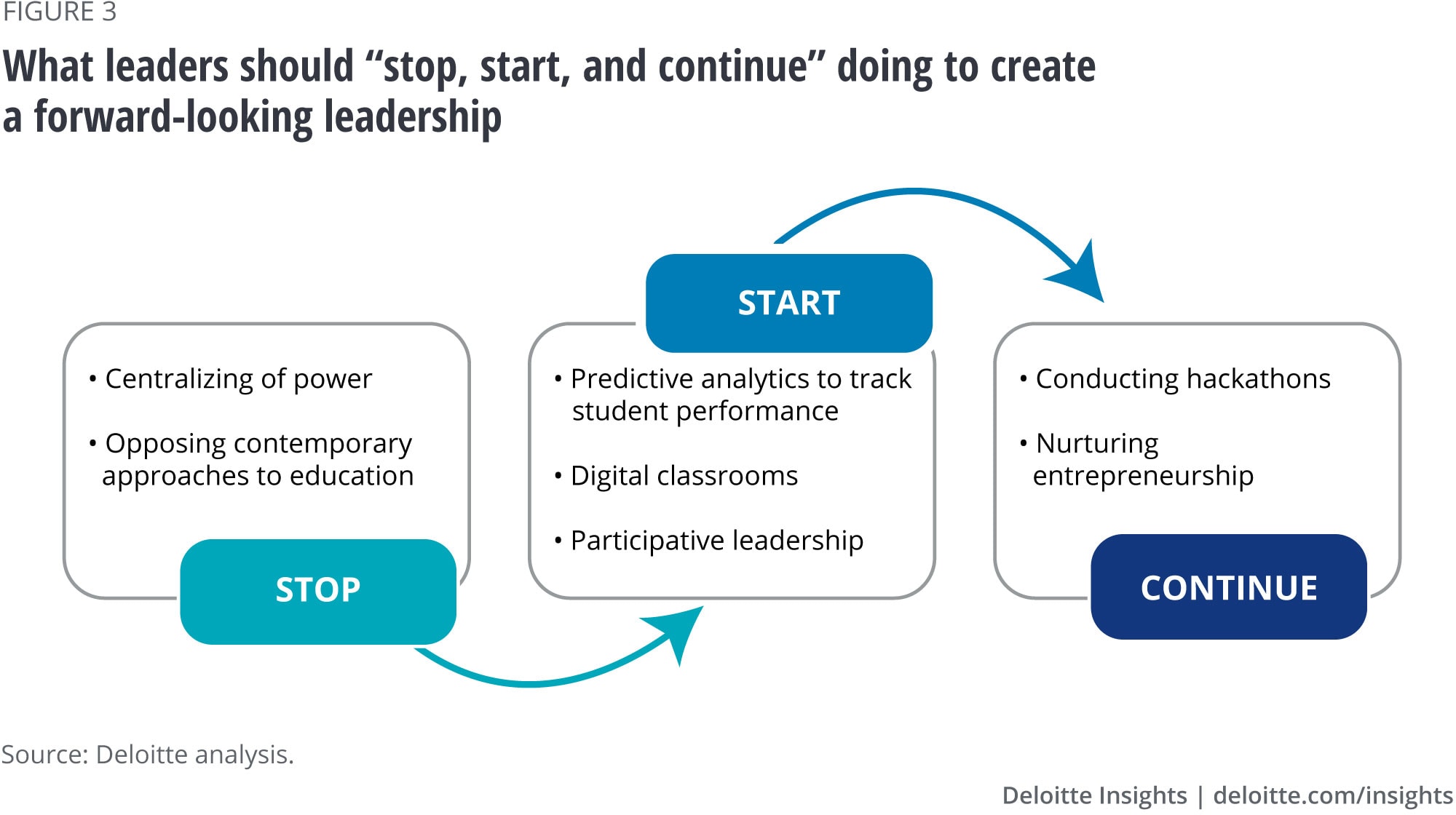
Pillar No. 2. Building a growth mindset
Reforming leadership capabilities as laid out in the previous section will be necessary but not sufficient to ensure successful student outcomes. It will be equally essential to provide students with a conducive psychological environment, one which motivates them to build on their abilities. Educators need to cultivate a growth mindset as part of the institutional culture.
A growth mindset, as pioneered by Carol Dweck, professor at Stanford University, views intelligence as fluid, and that can be developed over time as opposed to being regarded as a fixed trait.25 In a set of experimental studies on students aged 9 to 12 years, Dweck and her colleagues demonstrated how praising students’ efforts instead of their intelligence can significantly impact their learning and persistence.26 What’s more, students who were praised for their efforts fared better in future tasks in comparison to their counterparts who were praised for their intelligence.27
Other empirical studies have established a positive effect of a growth mindset on GPA scores. A recent experimental study assessed the impact of two quick 25-minute growth mindset programs on over 12,000 ninth-grade students in the United States. As a result of the intervention, lower-achieving students witnessed a jump in their GPA by 0.10-grade points as compared to students in the control group.28
Similarly, a growth mindset that values efforts over intelligence and rewards out-of-the-box thinking needs to be embedded in the postsecondary institutional culture in India today. Educators need to use two essential levers for promoting the growth mindset. The first is to embrace failure. By encouraging students to view failure as an opportunity to learn, and by fostering a learning culture that rewards risk and mistakes, educators can boost student motivation and achievement.29 The second lever relates to formative feedback. Replacing exam-based evaluation with more detailed and constructive feedback can result in better student persistence.30
At an organizational level, Microsoft has long espoused the concept and worked toward making it an integral part of their organizational culture by facilitating collaboration across disciplines, rewarding high-risk takers, and redefining talent programs.31
Create a culture that encourages failure and rewards challenges
Educators need to depart from the age-old mindset of viewing failure as a stigma. Working closely with students to help them learn from their mistakes and praising their efforts to progress in the right direction are core tenets of the growth mindset. Interestingly, the use of EdTech can help generate greater impact in this case. For instance, by using specific AI-based methods to target students at risk of low performance, educators can develop appropriate intervention strategies in the form of personalized coaching and mentoring. Georgia State University in the United States is one of the early pioneers of deploying predictive analytics to identify at-risk students and develop a personalized intervention. As a result, the university has been able to improve its graduation rates significantly.32
It is important, however, to not practice what has increasingly been recognized as the “false growth mindset.” In this case, teachers do not correctly imbibe the concept of a growth mindset and heap empty praise on students without actually helping them to embark on the path of learning by doing.33
Gradually replace exam-based evaluation with constructive feedback
Another important component of a growth mindset is formative feedback. Exam-based evaluation and the marks-centric approach in the Indian education system needs to pave the way for more constructive feedback based on effective listening and nurturing. Global institutions are evolving best practices to innovate evaluation mechanisms. For instance, the University of Pittsburgh in the United States endorses a scaffolding pedagogical strategy based on three essential elements of formative feedback—providing a general comment or a score, identifying areas where there has been visible improvement (strength areas), and recognizing areas that need improvement (areas ripe for growth).34
In addition to using the two core levers, educators can spread greater awareness on the potential benefits of developing a growth mindset beyond the institution. To ensure that the growth mindset is all-pervasive and deeply embedded, educators can work alongside parents who play a crucial role in the decisions students make.
It’s interesting to note that while the concept of developing a growth mindset for students has received adequate attention (at least in the West), not much has been written on cultivating the same for educators. Instead of exerting pressure on faculty members to jump on to the technology bandwagon, leaders will need to start recognizing willingness on the part of the educators to flex their pedagogical styles to stay ahead of the curve.
Students’ feedback for faculty will be an important input here. According to our survey, student body meetings and faculty representative sessions are the two popular methods of collecting feedback at Indian institutions. Interestingly, our survey insights also reveal the types of interventions adopted by leaders in response to student feedback. For instance, in an institution, low-performing teachers were mentored by high-performing ones to improve their instructional skills.35 Peer-learning is another effective way for faculty to build on their skill sets. However, only 17 percent of academicians in our survey recognized peer mentoring for faculty as an important priority for educators.36
“Stop, start, and continue”
After much deliberation during our lab sessions, deans and academicians identified things that they should “stop, start, and continue” doing under each of the three pillars. Figure 4 shows the action items identified for the second pillar—building a growth mindset.
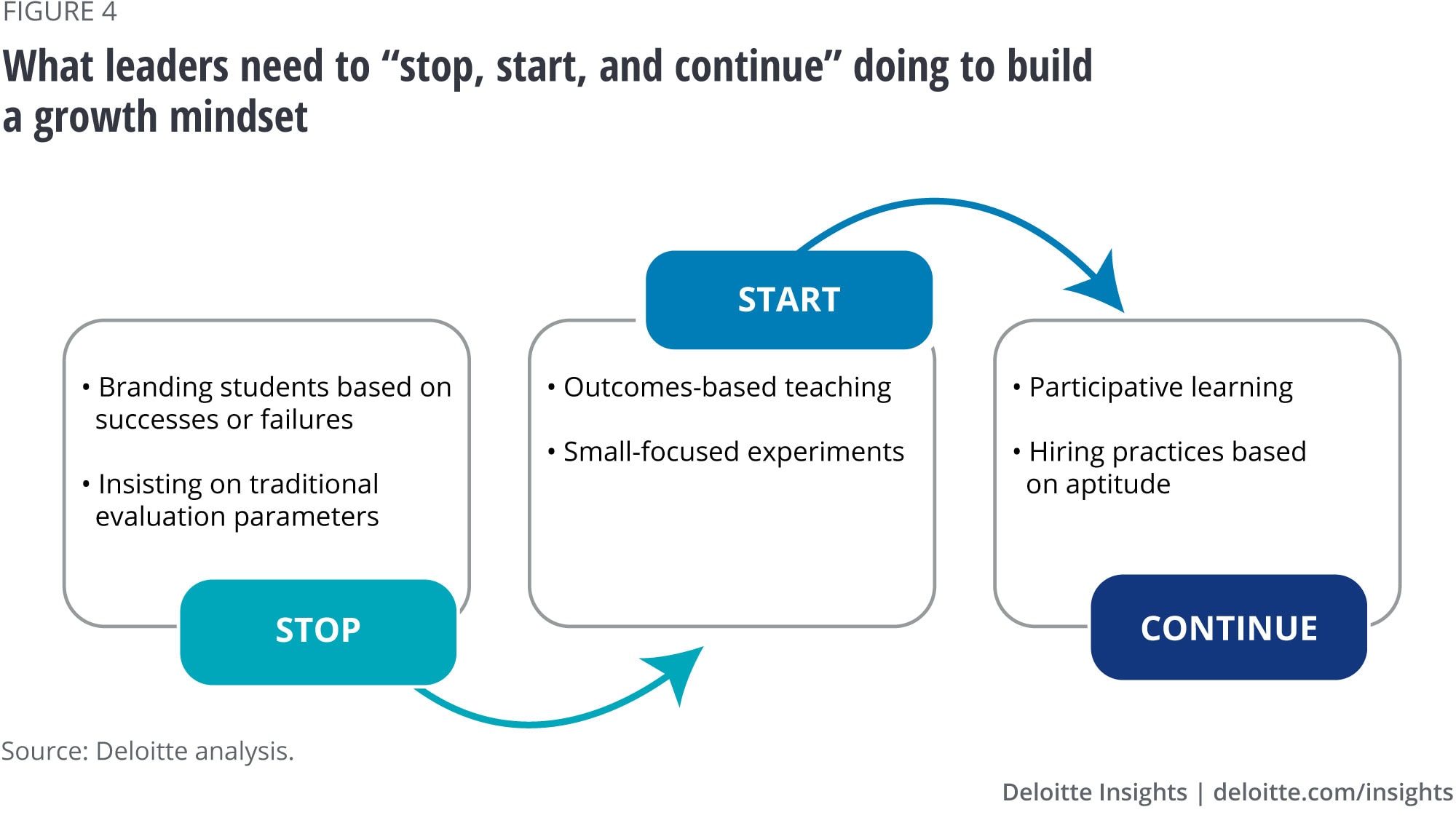
Pillar No. 3. Redesigning learning models
Institutions need to experiment with new and innovative platforms for learning that is better suited for the present-day learner who prefers flexible and interactive methods of learning. Educators can also cocreate learning models and the curriculum with students. What’s more, they can tap into programs launched by other stakeholders. For instance, educators can encourage students to leverage SWAYAM, an online education portal launched by the Government of India, to facilitate interactive and inclusive education.37
While helping students develop critical skills is one of the objectives of innovating learning models, preparing the student to be a life-long learner is equally crucial. Below are some methods that can be adopted:
Experiential learning
In the simplest terms, experiential learning can be equated to learning by doing or learning through experience.38 This method of learning where students step out of the classroom and engage with industry experts, as well as work on real-life cases, has started to gain prominence at various Indian institutions. For instance, under ISB’s Experiential Learning Programme (ELP) for the post graduate programme in management (PGP), a small group of students directly engage with a sponsoring company and work closely with the appointed faculty adviser and industry experts to solve real-world business problems.39
Experiential learning in the form of internships/apprenticeships can help students receive real-time feedback from employers on their skills and industry knowledge. An in-house career counselor or a career service cell can help complement such a model of learning.
Our survey results suggest that around 82 percent of students prefer experiential learning or learning through simulations and mock sessions. Comparatively, about 41 percent chose classroom training as their preferred option. Besides, over 90 percent of academicians in our survey suggested that they have either already adopted or plan to adopt experiential learning.40
Interdisciplinary learning
Interdisciplinary programs provide a platform for students to choose a course blend of their choice. Pursuing a mix of disciplines offers a chance for students to connect the dots while thinking critically and creatively. Some institutions in India have already started to implement this model of learning. For instance, the Cluster Innovation Centre at the University of Delhi offers an interdisciplinary program in humanities and social sciences. The program enables students to build competency in an array of disciplines such as journalism, art and design, education, and counseling. This further equips students to envision their career path better and choose an appropriate profession.41
In another example, IIT’s interdisciplinary program in educational technology is composed of faculty and associate members from multiple disciplines including engineering, humanities, social sciences, and management to name a few.42
Life-long learning: 60-year curriculum
The “once and done” approach can only take learners so far. Universities will have to eventually start designing courses that can be subscribed to at any time and any place. In fact, select universities have already taken measures to construct a model for continuous learning. The Center for Lifelong Learning (CLL) at India’s Tata Institute of Social Sciences (TISS) caters to two distinct types of adult learners—the working professionals who want to reskill themselves and those who have never had access to formal education and wish to take up formal learning.43 In another example, the Institute of Lifelong Learning at the University of Delhi was set up to help instructional staff, noninstructional staff, and students at the university to build their information and communications technology (ICT) skills.44
Likewise, a 60-year curriculum model has been widely discussed by educators around the globe. The model is not based on fixed content, and instead, mimics a subscription-based marketplace for education that permits learners to have full control over their educational journey.45 Some of the flexible options that such a curriculum can offer include online degrees/badges, massive open online courses (MOOCs), and weekend/evening classes.46
Learning models + Emphasis on skills development = Better learner experience
Developing learning models is just one step. It has to be supplemented with restructuring and realigning course curricula to help students build skills of the future. The shelf life of skills has plunged to only five years in recent times and has been marked by a dramatic shift toward soft skills that are critical in the market today.47 Over 85 percent of the alumni surveyed suggested that interpersonal and communication skills, a problem-solving approach, and critical thinking are important to be successful in the job market today. According to a World Economic Forum (WEF) study, some of the emerging soft skills in the Indian context include analytical thinking, active learning, creativity and initiative, and critical thinking.48
However, it seems that students are not fully aware of this development. For instance, according to our survey results, around 54 percent of student respondents indicated to have been ramping up on certifications for technical skills such as reporting and analytics, digital tools, and programming languages, while only 21 percent of such respondents chose certifications in soft skills to be as critical.49
“Stop, start, and continue”
After much deliberation during our lab sessions, deans and academicians identified things that they should “stop, start, and continue” doing under each of the three pillars. Figure 5 shows the action items identified for the third pillar—redesigning learning models with innovative approaches.

Student-centricity and collective effort are key to success
To successfully reform India’s higher education system, the three pillars of leadership, growth mindset, and innovative learning models will have to work collectively. They are interdependent and cannot operate in isolation. For instance, cultivating a growth mindset is necessary but not sufficient. It has to be backed by sound leadership strategies that are committed to fostering innovation and experimentation.
Similarly, innovating learning models cannot happen in a vacuum. Inputs from the industry and the alumni will weigh in heavily. A highly interactive and engaged stakeholder ecosystem will, therefore, be foundational to experimenting with learning and teaching styles.
Reforming the higher education sector cannot happen overnight and will need to be phased over the years to come. Leaders will have to draft a blueprint to make this transition as smooth as possible. Staying attuned to the external forces and revisiting internal strategies at defined intervals will be pivotal. But most importantly, as they try to understand the demands of the changing nature of work and take action to address the associated challenges, leaders would have to keep the most important stakeholder at the heart of everything they do—the students.
Explore the future of work
-
2025 Global Human Capital Trends Article1 month ago
-
The future of work in health and human services Article4 years ago
-
Opportunity marketplaces Article5 years ago
-
Inclusion as the competitive advantage Article5 years ago
-
The future of work in manufacturing Article5 years ago
-
Government jobs of the future Collection
